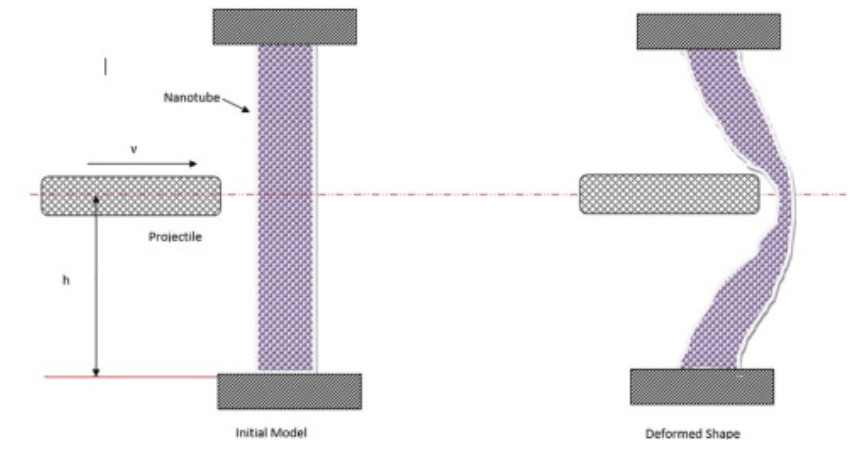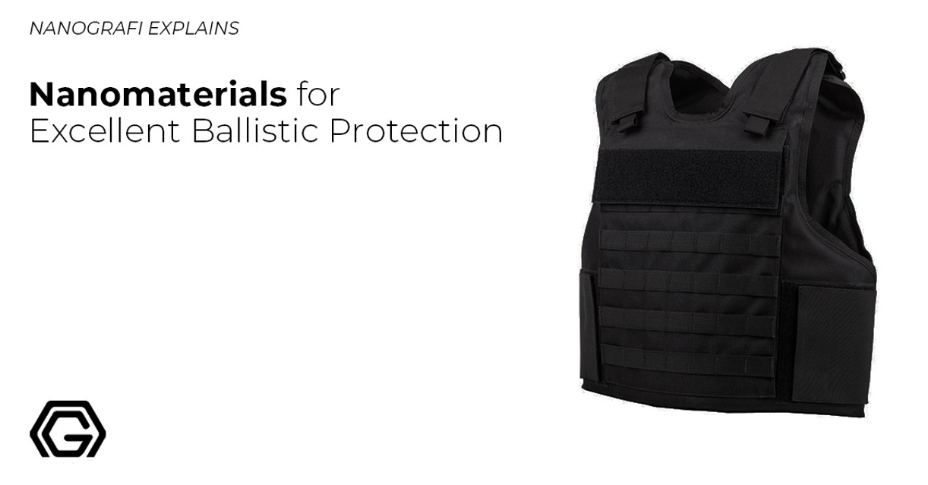Carbon Nanotube Body Armor for Enhanced Protection
The quest for innovative body armor capable of offering unparalleled protection against ballistic threats and impacts has led to the integration of cutting-edge materials into armor design. Among these advancements, carbon nanotubes (CNTs) have emerged as a revolutionary component in the development of body armor.
Their exceptional mechanical properties at the nanoscale, including high strength, flexibility, and lightweight nature, have paved the way for the creation of next-generation body armor capable of providing superior protection to military personnel, law enforcement officers, and civilians. In the realm of personal protection, the integration of advanced materials into body armor has been instrumental in enhancing the safety and survivability of individuals facing ballistic threats and impacts. In light of these innovative advancements in body armor, Nanografi, which specializes in nanomaterial production, plays a crucial role in supplying high-quality carbon nanotubes (CNTs) and other advanced materials essential for the development of next-generation protective gear.
Introduction
The utilization of carbon nanotubes in body armor represents the convergence of cutting-edge science, material innovation, and the imperative need for robust personal protection. As we navigate through the intricacies and advancements in CNT-based armor, we unveil a realm where nanotechnology meets the demands of safety and security in an ever-evolving landscape of threats and challenges.
Personal body armour is one of the most important pieces of equipment to protect human beings from various critical and fatal injuries. In today’s modern world, various organizations including law enforcement and security service have made it mandatory for their personnel to wear personal protection system while on field duty. However, the systems should comprise an improved ballistic performance, light-weighted, flexible as well as comfortable panel not only to be accepted with a wider range but also for effective performances of the consumer. Generally, the overall performances of the protective body armour could be affected by various parameters including armour design techniques, type of materials used and finishing of the panels.
Understanding Carbon Nanotubes and their Attributes
Carbon nanotubes are cylindrical carbon structures with remarkable properties owing to their unique molecular arrangement. These structures, often just a few nanometers in diameter, possess exceptional strength, flexibility, and resistance to deformation. Their inherent properties make them ideal candidates for various applications, including body armor, where high-performance materials are crucial for personal protection against ballistic threats.
Properties and Mechanics of Carbon Nanotube Body Armor
The integration of carbon nanotubes into body armor marks a paradigm shift in protective gear technology. These nanoscale materials offer a combination of extraordinary strength, lightweight characteristics, and flexibility that surpasses the capabilities of conventional armor materials. As a result, CNT-based body armor promises enhanced protection without compromising wearer mobility and comfort, significantly impacting the safety and survivability of individuals in high-risk environments.
Exceptional Strength-to-Weight Ratio
One of the most compelling characteristics of carbon nanotubes in body armor is their exceptional strength-to-weight ratio. The tensile strength of CNTs surpasses that of most traditional materials used in armor construction, allowing for lightweight yet incredibly robust armor solutions that offer superior protection without compromising mobility.
Flexibility and Impact Resistance
Carbon nanotube-based body armor demonstrates remarkable flexibility and impact resistance. The inherent flexibility of CNTs allows the armor to conform to the body, ensuring comfort and ease of movement for the wearer. Simultaneously, their ability to absorb and disperse impact energy helps mitigate the force of ballistic threats, minimizing the risk of injury.
Multi-layered Protection and Energy Absorption
CNT-based body armor often employs a multi-layered structure, utilizing the unique properties of nanotubes to create effective energy absorption mechanisms. These multiple layers work synergistically to distribute and dissipate the energy generated by ballistic impacts, effectively reducing trauma to the wearer.

Figure 1. Ballistic impact on carbon nanotube bulletproof vest.
Applications and Development of Carbon Nanotube Body Armor
Carbon nanotube body armor represents a revolutionary advancement in protective gear, offering strength and flexibility for diverse applications ranging from military and law enforcement to civilian and industrial uses.
Military and Law Enforcement Applications
The implementation of carbon nanotube body armor holds immense promise for military and law enforcement personnel. The lightweight yet robust nature of CNT-based armor allows for enhanced protection without sacrificing mobility, offering crucial advantages in dynamic operational scenarios.
Civilian Protection and Industrial Uses
Beyond military and law enforcement applications, carbon nanotube body armor has potential civilian applications, including personal protection for security personnel, emergency responders, and individuals operating in high-risk environments. Additionally, the adaptability of CNT-based armor extends to industrial uses, providing protective gear for workers in hazardous occupations.
To read applications of graphene in military, visit our blog page.
Manufacturing Challenges and Technological Advances
Production challenges and scaling persist in the large-scale production of carbon nanotubes for use in body armor, despite their remarkable properties. Key focuses include overcoming manufacturing hurdles such as cost-effectiveness and uniformity in large-scale production to make CNT-based armor more accessible and practical for widespread use. Simultaneously, advancements in material science and fabrication techniques are driving innovations in this field. Researchers are exploring novel approaches to optimize the arrangement and alignment of nanotubes within armor matrices, which is expected to enhance their ballistic performance and energy absorption capabilities.
Safety, Durability, and Environmental Considerations
Ensuring the safety and comfort of individuals wearing carbon nanotube body armor remains a priority. Extensive testing and evaluation ensure that CNT-based armor meets safety standards while providing the wearer with comfort and ergonomic design for extended use.
The durability and longevity of carbon nanotube body armor are also crucial aspects. Rigorous testing and evaluation procedures ascertain the resilience and shelf life of these advanced materials, ensuring that they maintain their protective qualities over time and under various environmental conditions.
In addition, assessing the environmental impact and sustainability of CNT-based armor production processes remains an important consideration. Efforts to develop eco-friendly production methods and recycling techniques are underway to minimize the environmental footprint associated with the manufacturing and disposal of nanotube-based protective gear.
What is the role of nanomaterials in ballistic protection? Learn now.
Future Prospects and Advancements in CNT Armor Technology
Despite the transformative potential, challenges persist in the widespread adoption of carbon nanotube body armor. Manufacturing scalability, cost-effectiveness, safety compliance, and environmental sustainability remain focal points for further research and development. Future endeavors aim to address these challenges, fostering innovations that propel CNT-based armor towards increased accessibility and practicality.
Advancements in Design and Performance
The future of carbon nanotube body armor holds promise for further advancements in design and performance. Continued research and development aim to optimize nanotube alignment, composite structures, and additional functionalities such as heat resistance and adaptability to varying threat levels.
Smart Armor and Integration of Nanotechnology
The integration of nanotechnology into body armor could lead to the development of "smart" armor systems. This innovation may incorporate sensors, adaptive materials, and real-time threat analysis, enabling the armor to adapt its protective capabilities dynamically to varying threats, significantly enhancing wearer safety.
Mechanisms and Superior Protection
Carbon nanotube body armor showcases superior protective mechanisms owing to its ability to disperse and absorb impact energy. The multi-layered design harnesses the unique properties of CNTs, effectively distributing and mitigating the force generated by ballistic threats, thereby reducing trauma and improving the survivability of wearers.
Diverse Applications and Evolving Innovations
The applications of carbon nanotube body armor span across military, law enforcement, and civilian sectors. Their adaptability and effectiveness offer protection for personnel in high-risk environments, while ongoing innovations in material science continue to drive advancements, exploring new frontiers for tailored, adaptable, and smart protective gear.
In conclusion, the integration of carbon nanotubes into body armor epitomizes the convergence of scientific innovation, material advancement, and the imperative need for enhanced personal protection. The trajectory of CNT-based armor heralds a future where nanotechnology continues to shape the landscape of protective gear, offering innovative solutions that redefine safety standards and empower individuals facing dynamic threats. The evolution of carbon nanotube body armor stands as a testament to human ingenuity and the relentless pursuit of safety and security in an ever-evolving world of challenges. As research and innovations propel these advancements forward, the promise of improved protection and survivability for individuals across various sectors remains a beacon guiding the future of protective gear.
Conclusion
In conclusion, the integration of carbon nanotubes in body armor represents a monumental leap in personal protective equipment technology. The exceptional mechanical properties of CNTs, including strength, flexibility, and lightweight nature, have propelled the development of advanced body armor capable of offering superior protection against ballistic threats and impacts.
While challenges such as manufacturing scalability and environmental impact persist, ongoing research and innovations promise a future where carbon nanotube body armor continues to evolve, offering enhanced safety and protection for individuals in diverse operational and civilian settings. The exceptional attributes of carbon nanotubes, including remarkable strength, flexibility, and lightweight nature, have redefined the capabilities of body armor materials. Their strength-to-weight ratio surpasses traditional materials, enabling the creation of lightweight yet incredibly robust protective gear that provides enhanced safety without compromising wearer mobility.
For an insight into these innovative technologies, explore Nanografi's range of carbon nanotube products, offering the pinnacle of protection and lightweight advantages.
References
Abtew, M. A., Boussu, F., & Bruniaux, P. (2021). Dynamic impact protective body armour: A comprehensive appraisal on panel engineering design and its prospective materials. Defence Technology, 17(6), 2027–2049. https://doi.org/10.1016/J.DT.2021.03.016
Analyzed: Carbon Nanotubes - Nanografi Nano Technology. (n.d.). Retrieved January 15, 2024, from https://nanografi.com/blog/analyzed-carbon-nanotubes/
Applications of Graphene in Military - Nanografi Nano Technology. (n.d.). Retrieved January 15, 2024, from https://nanografi.com/blog/applications-of-graphene-in-military/
Carbon Nanotubes Make Lighter Body Armor | The Graduate School | Washington State University. (n.d.). Retrieved January 15, 2024, from https://gradschool.wsu.edu/carbon-nanotubes-make-lighter-body-armor/
Lightweight armor material made of nanotube mats outperforms Kevlar. (n.d.). Retrieved January 15, 2024, from https://newatlas.com/materials/ultralight-armor-material-outperforms-kevlar-steel/
Nanomaterials for Excellent Ballistic Protection - Nanografi Nano Technology. (n.d.). Retrieved January 15, 2024, from https://nanografi.com/blog/nanomaterials-for-excellent-ballistic-protection/
New lightweight super material could battle bullets, deflect space debris. (n.d.). Retrieved January 15, 2024, from https://news.wisc.edu/new-lightweight-super-material-could-battle-bullets-deflect-space-debris/
Soorya Prabha, P., Ragavi, I. G., Rajesh, R., & Pradeep Kumar, M. (2021). FEA analysis of ballistic impact on carbon nanotube bulletproof vest. Materials Today: Proceedings, 46, 3937–3940. https://doi.org/10.1016/J.MATPR.2021.02.424
sp2nano | Graphene Carbon Nanotubes Materials & Body Armor. (n.d.). Retrieved January 15, 2024, from https://www.sp2nano.com/
The Best Way to Utilize Carbon Nanotubes in Industry with Potential Applications - Nanografi Nano Technology. (n.d.). Retrieved January 15, 2024, from https://nanografi.com/blog/the-best-way-to-utilize-carbon-nanotubes-in-industry-with-potential-applications/
Recent Posts
-
Advanced Materials for Unmanned Aerial Vehicle (UAV) Protection Against Laser
Consider a UAV on a critical mission, rendered inoperative by a sudden laser attack. With the increa …26th Jul 2024 -
Simulation and Modeling of Material Properties
Our world is composed of a dazzling array of materials, each with its own unique properties that dic …19th Jul 2024 -
Advanced Coatings for Superior Corrosion and Wear Resistance
Corrosion and wear pose significant challenges across various industries, leading to substantial eco …12th Jul 2024







